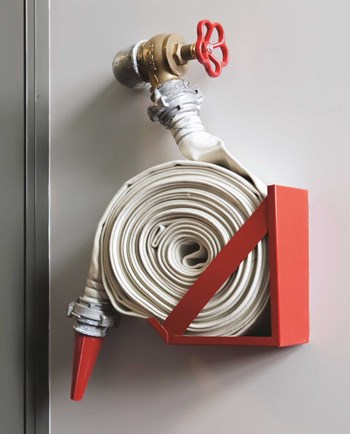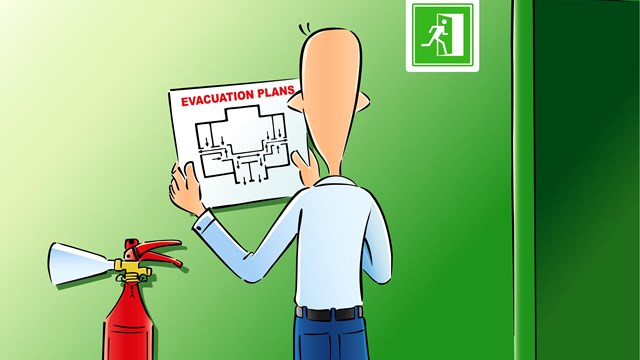
The discovery of fire is considered a major turning point in man's evolution from cave dweller to outer space explorer. Control of fire allowed early man warmth for his habitat, a way to cook his meals, and light for his surroundings. Fire also provided a means to frighten away predators and introduced a social element by bringing other humans together in a communal setting.
Harnessed and used for good, fire remains a wonderful tool for progress—but when out of control, flames are a deadly, devastating force. It is mankind’s best friend and fiercest enemy.
A Bit of History
The history of firefighting is probably as old as the element itself, but organized firefighting can be traced back to ancient Egypt where hand-operated pumps and bucket brigades were first employed to extinguish runaway flames.
Hand pumps and buckets were the state of the art in firefighting until 1672, when Dutch inventor Jan Van der Heiden invented the fire hose. Van der Heiden’s design was constructed of flexible leather coupled with brass fittings every 50 feet. The design was so perfect that the length and connections still remain the industry standard today.
The first fire engine appeared on the scene in 1725 and is attributed to Richard Newsham of London, England. Teams of men were employed to operate the manual pumps on specially designed horse-drawn carts when fire broke out. These early engines could deliver up to 160 gallons per minute at up to 120 feet in distance.
In this country, devastating fires in Jamestown and Boston inspired citizens to take greater measures towards combating fires. By 1648, Fire Wardens were appointed to patrol most cities—specifically to inspect chimneys, where most fires started. If fire was spotted during the night watches, the wardens would rouse the citizens to form bucket brigades. Wooden chimneys and thatched roofs were eventually outlawed, and heavy fines levied on non-compliant citizens.
The first volunteer fire company in America, the Union Fire Company was created by Benjamin Franklin in 1736 in Philadelphia. George Washington was also a volunteer firefighter with the Friendship Veterans Fire Engine Company in Alexandria, Virginia. In fact, Washington bought and donated Alexandria’s first fire engine.
By 1850, full-time firefighters were employed in most cities, but even after the formation of paid fire companies, there were disagreements and fights over territories. The early fire companies were paid by insurance companies, and turf wars between responding units were common. Government-run fire departments first appeared around the time of the Civil War. Today, fire and rescue is often a mix of full-time paid, paid-on-call, and volunteer responders. Most major cities are served by large, paid, well trained firefighting teams.
We Didn't Start the Fire
The majority of residential fires are a result of careless actions and habits of residents and often, completely avoidable. The winter months pose an increased problem with portable space heaters setting on fire, says David Buoncuore, fire marshal at the Hoboken Fire Department. “People tend to leave them on and unattended. The problem occurs when they are leaning against furniture or window treatments,” he says.
After unattended cooking, heating is the second leading cause of fires in condo and co-op buildings, says Jeffrey M. Amato, PE, senior fire protection engineer at Manhattan-based Hughes Associates, Inc., a firm that also does work in New Jersey. “It applies to those fires that are caused by functioning or malfunctioning central heating units, fixed or portable local heating units, fireplaces, heating stoves, chimneys, and water heaters. In the late 1970s and early 1980s, heating was actually the leading cause, due to a surge in the use of alternative space heaters and wood heating,” he says.
Electrical circuits and power strips can also be cause for concern, especially during the holiday season when they are overloaded with plugs. “Electrical issues are also prevalent these days due to more and more people using high energy electrical equipment plugged into sockets that have not been upgraded. People also tend to misuse power strips and overload them with too many appliances,” Buoncuore says.
Fire Prevention in Multifamily Buildings
Fortunately with careful actions and monitoring, most residential fires can be prevented. But fire prevention encompasses more than just turning off your stove or not throwing a lit cigarette in the trash; there are a few key practices that boards and residents should know and engage in.
Your first line of defense is fire alarms. “Residents need to make sure their smoke detectors and carbon monoxide detectors are in working order. That means changing the batteries twice a year,” Buoncuore says.
Residents and managers should test smoke detectors monthly and change batteries every six months, says Mike Teets, fire chief at the Newton Fire Department in Sussex County. An easy way to remember battery changes is to schedule them with daylight savings: when you change the time, you change your batteries, he says.
Sprinkler systems, which are now a standard feature rather than an amenity in multifamily homes, are extremely valuable when it comes to fire prevention. “A fire sprinkler system protects lives and property by keeping fires small. Because the sprinkler system reacts so quickly, it can dramatically reduce the heat, flames, and smoke produced in a fire, allowing people more time to escape safely,” says Judy Comoletti, division manager of public education for the National Fire Protection Association (NFPA).
Buoncuore adds that property managers should maintain all building features that aid in fire safety. This means ensuring that emergency lights are working properly, exit signs are lit and working, smoke detectors in all common areas are functioning and that all fire protection systems such as sprinkler systems and fire alarm panels are in working order, he says.
When developing a prevention/evacuation plan for the building, an excellent starting place for all boards would be with the local fire department. Many fire departments will come out to residents and host a seminar about fire safety and prevention. Buoncuore also suggests having your local fire prevention bureau come in and discuss fire safety and prevention with residents. Many local departments will come in free of charge and having them give tips and advice is a good way to make sure that residents will listen. In addition to your fire department, the Federal Emergency Management Agency (FEMA) and NFPA have guidelines on how to establish the best evacuation plan.
Fire safety professionals advise residents to create individualized escape plans beginning with drawing out your floor plan, including bedrooms, windows and stairwells. Arrows should mark two ways out of each room. And remember, one plan isn't enough. It is important to at least two other evacuation options available in case your exits in Plan A become blocked or inaccessible.
After developing a plan, it must be shared with residents. “Building management and the homeowners association should meet regularly with residents to discuss fire prevention. Brochures or pamphlets prepared by building management are a good way of notifying residents of important issues. Whenever possible, hands-on training should be provided to demonstrate fire prevention, such as how to properly use alternative heating appliances. Residents should be made aware of any fire incidences in the building,” Amato says.
If there are residents requiring special assistance in the event of fire or other emergency, it is imperative to have an evacuation plan in place ahead of time. “People who may not be able to escape on their own need to have a plan to assist in their safe evacuation and management should know who may need assistance,” says Comoletti. “Include those who need assistance to plan how best to accommodate them. They will be able to provide input on the best methods for them to escape.”
She suggests installing an evacuation chair that can assist individuals with a mobility disability and providing residents opportunity on how to use it. It is also important to consider residents with service animals, as they may need to have a special evacuation plan prepared for them. All circumstances that require special assistance can be discussed with your local fire department.
Teets adds that it is important to establish a meeting place along with the evacuation plan which will serve as an accountability check of residents and pets. That way you will be able to do a count and notify the fire department of any persons that are missing and might still be inside, he says.
Then, it's practice, practice, practice. Simply being aware of a plan won't help you in a fire, when emotions and anxiety are running high. Holding monthly or quarterly “fire drills” for your building can help residents identify exits and meeting areas first hand and learn how to escape quickly, should a real fire take place.
“Fire evacuation procedures will only work if they are practiced. People need to know where to go. It may sound ridiculous, but most people will think that the only way out is the way they came in; that’s human nature. This is not always the case [during a fire]. Sometimes residents may need to evacuate in a smoke-filled environment. Sometimes the path that they came in may be obstructed. Fire drills are the only way you will be prepared accordingly. If evacuation drills are conducted periodically then, when a real fire occurs, everyone will be ready,” Buoncuore says.
In Case of Fire
In the event of a fire, it is imperative that residents remain calm and try to identify the best and quickest exit strategy. Another important tip for residents to remember is to feel the unit door before opening it to the common hallway. If the door is cool to the touch, the door may be opened slowly; if there is smoke present in the hallway the door should be closed immediately. A wet bath towel may be placed firmly along the inside of the door, and the fire department should be called immediately. A resident may then open a window and have a towel or scarf to signal the location of the unit and alert the fire and rescue team.
If the door is cool to the touch and there is no smoke a resident may move quickly but safely to the designated fire exit. Residents are urged to close doors to the unit in order to keep the fire from spreading from one unit to another. Leaving a door open allows fire and smoke to travel much quicker and can obstruct a potential exit for another resident.
The level of community involvement desired in the planning and preparation for emergency action will ultimately be a board decision. However, once those plans are in place all residents should be made aware of the details by the accepted method of community communication and updates and reviews should occur on a regular basis in order to ensure the health, safety and peace of mind of both residents and board members.
Anne Childers is a freelance writer and a frequent contributor to The New Jersey Cooperator. Editorial Assistant Maggie Puniewska contributed to this article.






Leave a Comment